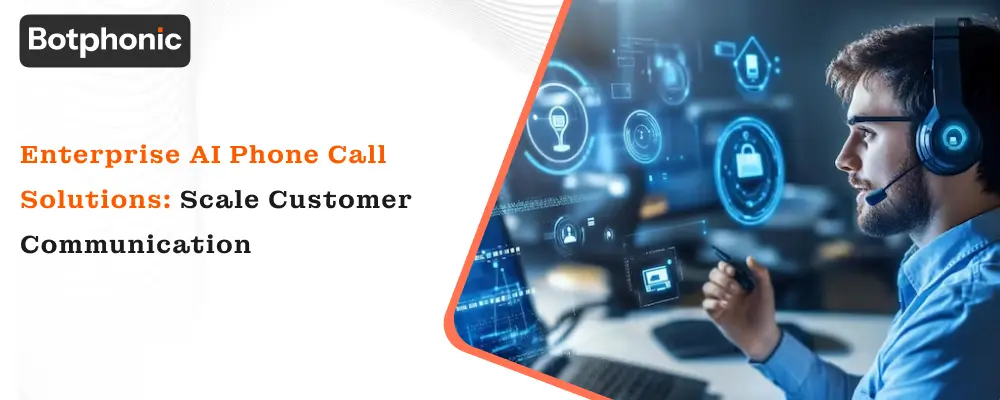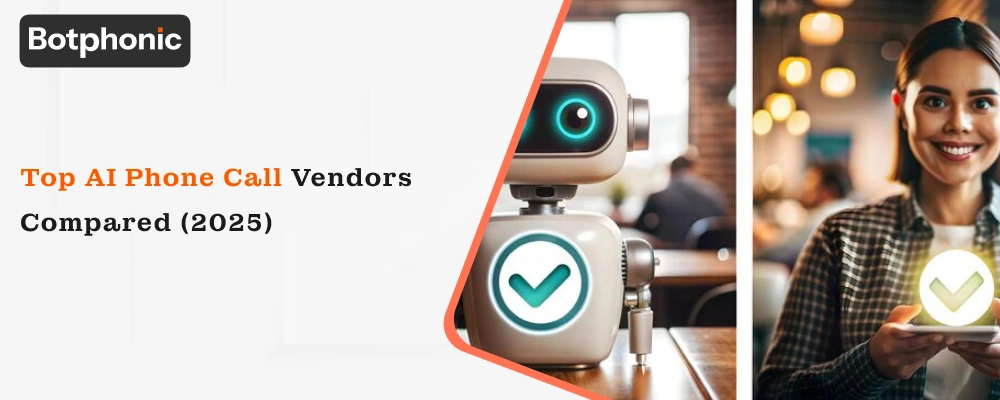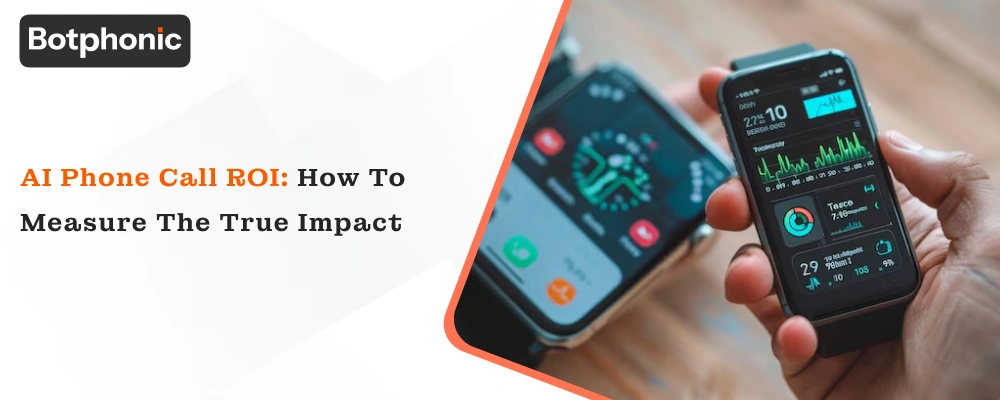
Summarize Content With:
Quick Summary
This blog analyzes the AI phone call ROI regarding operational, financial, and experiential aspects thoroughly. It explains the handling of customer interactions by the AI-driven systems through sophisticated AI phone call APIs, transcription tools, and real-time analytics, which eventually lead to turning every conversation into usable data.
Voice AI technology is now at par with enterprise-level reliability in terms of speed, security, compliance, and context-awareness. Banks, hospitals, telecoms, and retailers are the sectors that have started profiting from this technology. Whether it is for customer support, sales, or compliance, AI phone call assistants are always giving measurable efficiency, and on top of that, they are providing new insights for the business.
Introduction
Let’s get honest with each other and acknowledge that most boardrooms are still treating AI phone calls as an exclusive toy rather than revenue engines. But there’s also a cold math in here, let’s see: If an AI call assistant can just shorten a five-minute service call to two minutes, across numerous calls coming monthly, it’s not just proving “innovation” but a multimillion-dollar efficiency event.
Enterprises have spent decades in just optimizing every digital channel except the most well-known and old one; the phone. Now, AI phone call assistants are just rewriting those stories. They are listening, learning, responding, all while being scaled at another level. The only question that’s worth your CFO’s time is: “What’s the ROI?”
The Rise of AI Call Assistants and Enterprise Adoption
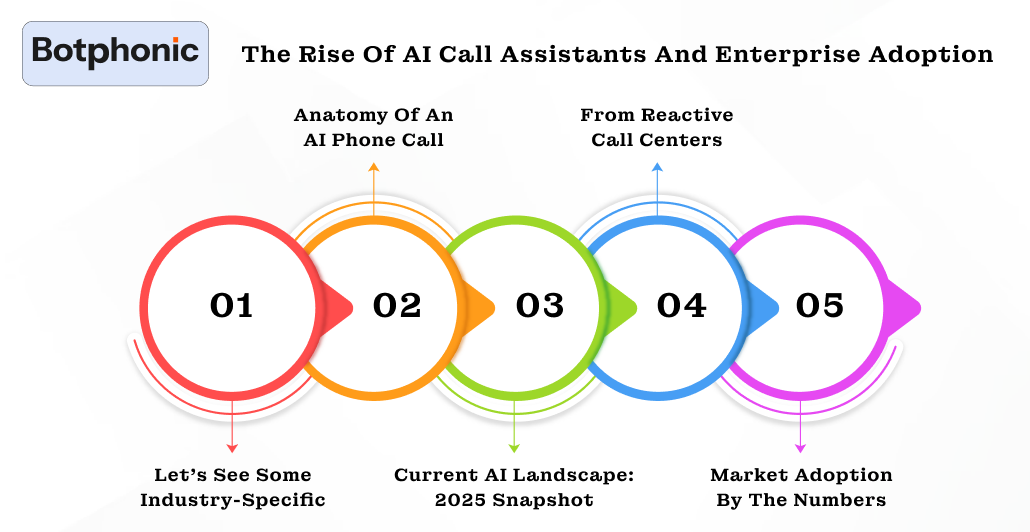
The very first attempts of AI at voice automation were quite primitive IVR (Interactive Voice Response) menus that were unable to comprehend regional accents and sentiments. The present-day AI telephone systems are based on neural speech models that can identify frustration, intent, and urgency in less than half a second.
The Botphonic AI is an example of this new generation; it is an enterprise-grade stack where natural-language understanding, contextual memory, and integration hooks are combined with rigorous data-privacy standards.
1. Industry-Specific Usage
AI phone calls have now become a part of every process; from outbound scheduling to inbound triage.
Let’s see some industry-specific usage of AI phone call assistants:
- Banking: Verification calls and card activation.
- Healthcare: Appointment reminders along with compliance logging.
- Retail: Voice bots are completely taking care of post-purchase surveys.
- Telecom: Plan upgrades and customer retention campaigns.
These are not experiments; they are fully functioning operations with ROI curves that can be measured.
2. Anatomy of an AI Phone Call
To measure ROI, you have to know what the moving parts are:
- Trigger: Customer call or an automated outreach via AI phone number to call.
- Speech Recognition: Real-time audio gets converted into text with 95 % + accuracy.
- Intent Mapping: NLU (Natural Language Understanding) models decode what the customer wants.
- Action Engine: Integrating AI phone calls helps in gathering data from CRM (Customer Relationship Management) and ERP (Enterprise Resource Planning) systems.
- Response Generation: Creates a reply that sounds human-like.
- Logging and Analytics: AI phone call transcribing and recorders make every interaction searchable data.
Every layer supplies KPIs: latency, completion rate, and escalation frequency, that are the ones that finally determine your AI phone call assistant ROI.
3. Current AI Landscape: 2025 Snapshot
- Latency: Topmost APIs reply in less than 250 ms, rendering talk-to-AI phone calls to be instant.
- Accuracy: Combined acoustic models drive transcription accuracy beyond 96%.
- Security: Zero-trust encryption is standard; no raw voice data leaves regional servers.
- Compliance: GDPR, CCPA, and telecom-sector frameworks now demand full audit trails.
4. From Reactive Call Centers to Proactive AI Voice Networks
Volume was the name of the game in traditional contact centers; today’s enterprises run on speed. The transition from reactive support desks to proactive communication stacks powered by AI took place gradually, and then it went off like a cannon as remote work became the norm for global workforces.
Today’s AI telephone representatives are not just limited to answering the calls according to their scripts. They learn through AI phone call APIs, which are capable of doing real-time speech recognition, vibrancy assessment, and customization of replies. Those systems operate being AI agents in the enterprise ecosystems, whatever the use case is; support triage, post-sale feedback, or lead qualification.
5. Market Adoption by the Numbers
According to the latest industry report, it has been found that more than 80 percent of companies are either implementing or scrutinizing conversational AI for the purpose of making or receiving phone calls. Botphonic AI; a voice platform for enterprises, claims that the calling expense of their clients drops by 35 to 60 percent during the first operating quarter itself.
How an AI Phone Call Actually Works
The customer calling in (or the outbound AI agent coming in) initiates a processing that takes milliseconds to unfold
- Speech Capture: The vocal input is transmitted through an AI phone call API that is linked to the telephony infrastructure.
- Natural-Language Understanding: The algorithm determines the wish and the mood of the speaker.
- Knowledge Retrieval: The integrated CRMs or knowledge bases provide specific answers.
- Speech Synthesis: The AI responds in a human-like manner, preserving the tone and the context.
- Transcription & Analytics: Every single interaction is stored via AI phone call transcription and recording tools for compliance and insight.
The fact that AI phone calls now supersede the legacy IVR systems is that they comprehend the input rather than merely reacting.
AI Overview: Current Insights and Market Momentum

1. Voice Tech Maturity
Voice AI has reached a stage where its reliability is akin to that of businesses. Neural models with low latency give responses in less than 300 ms, thus making talk-to-AI phone calls sound very human rather than mechanical. Businesses are using voice AI agents for phone calls that are expertly crafted for them, including the vocabularies of different industries; banking, healthcare, logistics, etc.
2. Ecosystem Expansion
The voice AI stack has evolved in three main layers:
- Core Intelligence: NLP engines such as Botphonic AI’s proprietary model can understand, interpret, and analyze multi-turn conversations.
- Application Layer: The AI phone-call note takers, recorders, and dashboards are keeping the BI tool updated with the metrics in real-time.
- Integration Layer: Salesforce, ServiceNow, or bespoke ERPs are among the systems with which APIs connect in order to complete the cycle from voice to data.
3. Emerging Niches
Even applications that are at the edge are still bordering, AI character phone calls for training simulations, celebrity AI phone calls for marketing stunts, and AI phone call recorders guiding automated compliance audits. Some consumer-grade tools may slip into NSFW areas, but by integrating AI Phone calls, enterprise-grade providers are always implementing governance models that are compatible with the data-privacy frameworks.
Defining AI Phone Call ROI
ROI must move past “calls handled” toward metrics that matter to finance and operations.
| ROI Component | Enterprise Metric | Impact Driver |
| Cost Efficiency | Cost per call vs. baseline | Labor reduction, automation rate |
| Speed | Average handle time | NLP accuracy, routing logic |
| Customer Experience | CSAT / NPS | Response quality, 24/7 availability |
| Revenue Enablement | Conversion uplift | AI-assisted outbound calls |
| Data Intelligence | Insights generated | Transcription analytics |
Formula:
ROI:
(NetBenefit–AIDeploymentCost)/AIDeploymentCost ×100
To measure AI phone call assistant ROI, enterprises must quantify both direct (labor and time) and indirect (experience and data) gains.
How to Measure ROI from AI Phone Call Assistants
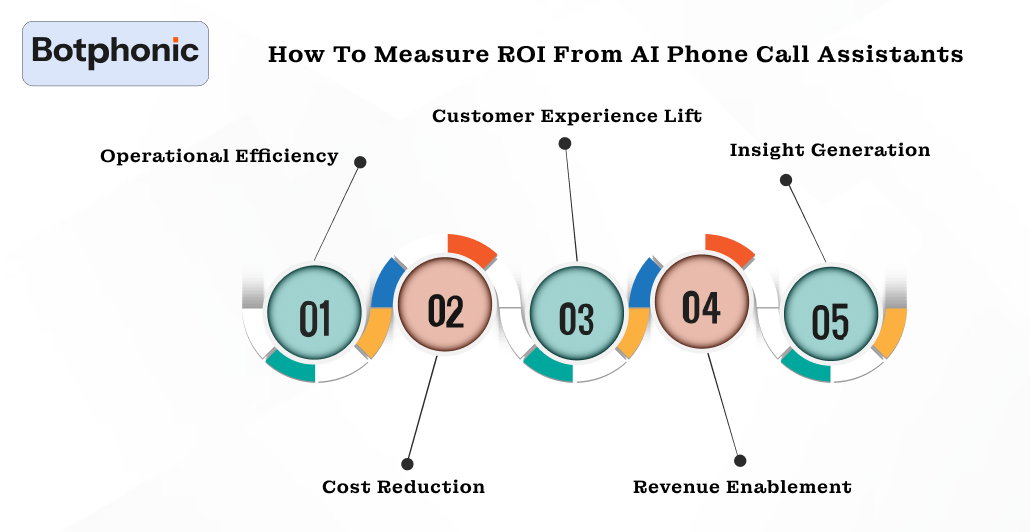
1. Operational Efficiency
Ensure to have benchmark pre-AI metrics, such as call duration, queue time, and transfer rates, as well. After deployment, track the delta. For example, a telecom client cut average handling time by 47 percent using Botphonic AI call assistant, which are already trained on historical call data.
2. Cost Reduction
You can consider salaries, training, benefits, and overhead of human agents versus per-minute AI operational cost. Usually, the enterprises regain the costs of deployment in 6 to 9 months when the automation covers 60 percent of the traffic.
3. Customer Experience Lift
AI provides a level of consistency that human workers cannot achieve through large-scale operations. It is common for CSAT (Customer Satisfaction) to go up by 10 to 25 points after the implementation of an AI system for managing phone calls of FAQs and routine questions.
4. Revenue Enablement
AI agents performing outbound calls can qualify leads anytime. In one retail experiment, AI-based callbacks are said to account for the conversion of 18 percent more leads than manual follow-ups – hence, having a direct impact on the ROI of the AI phone call assistant.
5. Insight Generation
Thanks to AI transcription and note-taking, the leadership teams obtain searchable conversation intelligence, which instantaneously assists in uncovering product flaws or churn triggers.
The Tools Behind the Metrics
- AI Phone Call APIs: Bridge telephony with NLP back-ends.
- Call Recorders & Transcribers: Enable compliance audits and keyword tagging.
- Analytics Dashboards: Show automation rates, interaction costs, and sentiment trends.
- CRM Connectors: Feed summarized data into sales and support pipelines.
Through Botphonic AI’s enterprise layer, the combination of these components creates a closed feedback loop that turns each call into quantifiable business intelligence.
Experience firsthand how smart voice automation delivers measurable and scalable ROI.
Try Botphonic Today!!Conclusion
The business telephone line has gradually become the next digital frontier. The traditional use of telephones in businesses, which previously took away a large chunk of their operating budgets, now takes the form of efficiency, insight, and growth. The AI-powered phone call assistants, which were considered as cutting-edge technology, are now indispensable and have become the chief sources of revenue for the whole organization.
Every data point created through an AI agent call translates into the power to make a decision in a more informed way. Thus, integrating AI phone calls changes from simply being reactive to becoming predictive for analytics purposes. Those companies that adopted this transition along with Botphonic AI are already turning the operational costs of staff into the benefits of valuable intelligence that drives profit.
The reality is that the return on investment of AI phone calls is not limited to the area of cost savings only; it is about transformation:
- From manual to fully automated.
- From disjointed to fully integrated with data.
- From passive to active and predictive.
The question now is not if the company should use AI for telecommunications but rather how quickly a business can get it installed before the competition does.
